| Home/ |
| Table of Content/ |
 |
|||||||||
|
|
|
|
Basic Renderers |
Here we start with creating a frame buffer in memory and writing it to a file of
the simplest possible raster format. It's |
 |
There is the first example, it's in |
#include <stdio.h> #include <string.h> #include "agg_rendering_buffer.h" enum { frame_width = 320, frame_height = 200 }; // Writing the buffer to a .PPM file, assuming it has // RGB-structure, one byte per color component //-------------------------------------------------- bool write_ppm(const unsigned char* buf, unsigned width, unsigned height, const char* file_name) { FILE* fd = fopen(file_name, "wb"); if(fd) { fprintf(fd, "P6 %d %d 255 ", width, height); fwrite(buf, 1, width * height * 3, fd); fclose(fd); return true; } return false; } // Draw a black frame around the rendering buffer, assuming it has // RGB-structure, one byte per color component //-------------------------------------------------- void draw_black_frame(agg::rendering_buffer& rbuf) { unsigned i; for(i = 0; i < rbuf.height(); ++i) { unsigned char* p = rbuf.row_ptr(i); *p++ = 0; *p++ = 0; *p++ = 0; p += (rbuf.width() - 2) * 3; *p++ = 0; *p++ = 0; *p++ = 0; } memset(rbuf.row_ptr(0), 0, rbuf.width() * 3); memset(rbuf.row_ptr(rbuf.height() - 1), 0, rbuf.width() * 3); } int main() { // In the first example we do the following: //-------------------- // Allocate the buffer. // Clear the buffer, for now "manually" // Create the rendering buffer object // Do something simple, draw a diagonal line // Write the buffer to agg_test.ppm // Free memory unsigned char* buffer = new unsigned char[frame_width * frame_height * 3]; memset(buffer, 255, frame_width * frame_height * 3); agg::rendering_buffer rbuf(buffer, frame_width, frame_height, frame_width * 3); unsigned i; for(i = 0; i < rbuf.height()/2; ++i) { // Get the pointer to the beginning of the i-th row (Y-coordinate) // and shift it to the i-th position, that is, X-coordinate. //--------------- unsigned char* ptr = rbuf.row_ptr(i) + i * 3; // PutPixel, very sophisticated, huh? :) //------------- *ptr++ = 127; // R *ptr++ = 200; // G *ptr++ = 98; // B } draw_black_frame(rbuf); write_ppm(buffer, frame_width, frame_height, "agg_test.ppm"); delete [] buffer; return 0; } |
In this example you don't even have to link it with any AGG files, you need only to
indicate the AGG |
When you compile and run it you should see the following result. |
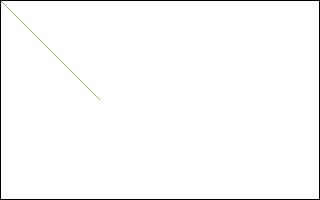 |
Almost everything here is coded “manually”. The only class we use is
rendering_buffer. This class doesn't know anything about
the pixel format in memory, it just keeps an array of pointers
to each row. It is your responsibility to allocate and deallocate
actual memory for the buffer. You can use any available mechanism
for that, a system API function, simple memory allocation, or even
an array defined statically. In the above example we allocate
|
Include file: agg_rendering_buffer.h |
The rendering buffer class keeps pointers to each rows, and basically it's
all it does. It doesn't look like a great achievement, but try to keep reading.
The interface and functionality of it is very simple.
It's a |
typedef row_ptr_cache<int8u> rendering_buffer; |
The interface and the functionality of class row_ptr_cache is: |
template<class T> class row_ptr_cache { public: row_ptr_cache(); row_ptr_cache(T* buf, unsigned width, unsigned height, int stride); void attach(T* buf, unsigned width, unsigned height, int stride); T* buf(); const T* buf() const; unsigned width() const; unsigned height() const; int stride() const; unsigned stride_abs() const; T* row_ptr(int, int y, unsigned) T* row_ptr(int y); const T* row_ptr(int y) const; row_data row (int y) const; T const* const* rows() const; template<class RenBuf> void copy_from(const RenBuf& src); void clear(T value) }; |
The source code: row_ptr_cache |
The class doesn't have any assertion or verification code, so that, your
responsibility is to properly attach an actual memory buffer to the object
before using it. It can be done in the constructor as well as with the
|
|
Function |
The cost of creation is just initializing of the variables (set to 0),
the cost of |
The most frequently used function is |
| IMPORTANT! The rendering buffer does not perform any clipping or bound checking, it's the responsibility of higher level classes. |
The accessors,
|
Function |
First, negate the stride when creating the rendering buffer object: |
agg::rendering_buffer rbuf(buffer,
frame_width,
frame_height,
-frame_width * 3);
|
The result is: |
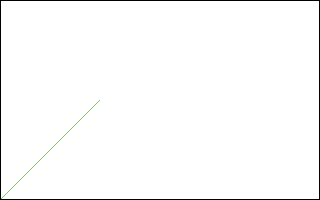 |
Second, let's try to attach to some part of the allocated buffer. This modification actually attaches to the same buffer twice, first, to the whole frame, then to its part, with 20 pixel margin. |
int main() { unsigned char* buffer = new unsigned char[frame_width * frame_height * 3]; memset(buffer, 255, frame_width * frame_height * 3); agg::rendering_buffer rbuf(buffer, frame_width, frame_height, frame_width * 3); // Draw the outer black frame //------------------------ draw_black_frame(rbuf); // Attach to the part of the buffer, // with 20 pixel margins at each side. rbuf.attach(buffer + frame_width * 3 * 20 + // initial Y-offset 3 * 20, // initial X-offset frame_width - 40, frame_height - 40, frame_width * 3 // Note that the stride // remains the same ); // Draw a diagonal line //------------------------ unsigned i; for(i = 0; i < rbuf.height()/2; ++i) { // Get the pointer to the beginning of the i-th row (Y-coordinate) // and shift it to the i-th position, that is, X-coordinate. //--------------- unsigned char* ptr = rbuf.row_ptr(i) + i * 3; // PutPixel, very sophisticated, huh? :) //------------- *ptr++ = 127; // R *ptr++ = 200; // G *ptr++ = 98; // B } // Draw the inner black frame //------------------------ draw_black_frame(rbuf); // Write to a file //------------------------ write_ppm(buffer, frame_width, frame_height, "agg_test.ppm"); delete [] buffer; return 0; } |
The result: |
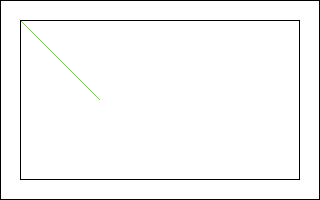 |
And the last modification is: |
// Attach to the part of the buffer,
// with 20 pixel margins at each side and negative 'stride'
rbuf.attach(buffer +
frame_width * 3 * 20 + // initial Y-offset
3 * 20, // initial X-offset
frame_width - 40,
frame_height - 40,
-frame_width * 3 // Negate the stride
);
|
The result: |
 |
In the last example we just negated the stride value, keeping the pointer to the beginning of the buffer as it was in the previous example. |
| NOTE Function write_ppm() writes the pixel map to a file. Hereafter it will
be omited in this text, but duplicated when necessary in source code in
the agg2/tutorial directory.
|
First, we create another, more civil example, which is in
|
#include <stdio.h> #include <string.h> #include "agg_pixfmt_rgb24.h" enum { frame_width = 320, frame_height = 200 }; // [...write_ppm is skipped...] // Draw a black frame around the rendering buffer //-------------------------------------------------- template<class Ren> void draw_black_frame(Ren& ren) { unsigned i; agg::rgba8 c(0,0,0); for(i = 0; i < ren.height(); ++i) { ren.copy_pixel(0, i, c); ren.copy_pixel(ren.width() - 1, i, c); } for(i = 0; i < ren.width(); ++i) { ren.copy_pixel(i, 0, c); ren.copy_pixel(i, ren.height() - 1, c); } } int main() { //-------------------- // Allocate the buffer. // Clear the buffer, for now "manually" // Create the rendering buffer object // Create the Pixel Format renderer // Do something simple, draw a diagonal line // Write the buffer to agg_test.ppm // Free memory unsigned char* buffer = new unsigned char[frame_width * frame_height * 3]; memset(buffer, 255, frame_width * frame_height * 3); agg::rendering_buffer rbuf(buffer, frame_width, frame_height, frame_width * 3); agg::pixfmt_rgb24 pixf(rbuf); unsigned i; for(i = 0; i < pixf.height()/2; ++i) { pixf.copy_pixel(i, i, agg::rgba8(127, 200, 98)); } draw_black_frame(pixf); write_ppm(buffer, frame_width, frame_height, "agg_test.ppm"); delete [] buffer; return 0; } |
This example doesn't look very different from the previous one, but the difference in its essence is great. Look at the declaration: |
agg::pixfmt_rgb24 pixf(rbuf); |
Here we create a low-level pixel rendering object and attach it to the rendering buffer. |
It defined as: |
typedef pixel_formats_rgb24<order_rgb24> pixfmt_rgb24; |
Class template pixel_formats_rgb24 has full knowledge about this particular pixel format in memory. The only template parameter can be order_rgb24 or order_bgr24 that determines the order of color channels. |
Unlike rendering_buffer, these classes operate with integer pixel
coordinates because they know how to calculate the offset for
|
Currently, in AGG there are the following files that implement different pixel formats: |
|
The pixel format classes define their native color space and the color type, for example: |
typedef rgba8 color_type; |
For |
| NOTE It's very important not to confuse the color type that the pixel format renderer works with and the native color space that the buffer represents. For example, you can pretend that you work with the CMYK color space using the RGB buffer (you just write a simple conversion function that creates an rgba8 object from some CMYK structure). But it will be only an imitation and you will have color losses, because there are some colors in CMYK that cannot be displayed with RGB and vice versa. To use the capabilities of some color space completely one has to write a pixel format renderer for that particular color space and to work in that color space without any intermediate conversions. |
| IMPORTANT! The pixel format classes do not perform any clipping operations, which means that working directly with these classes is generally unsafe. Clipping is the functionality of higher level classes. The reason of this design is simple — it must be as easy as possible to write your own pixel format classes. There can be many of them while the clipping code remains exactly the same. |
pixel_formats_rgb24(rendering_buffer& rb); |
The constructor of the pixel format renderers expects a reference to the created and fully initialized rendering_buffer. The cost of creation is minimal, basically it's initializing of one pointer. |
The pixel format renderers must expose the following functionality (interface). |
unsigned width() const { return m_rbuf->width(); } unsigned height() const { return m_rbuf->height(); } |
Returns width and height of the buffer in pixels.
|
color_type pixel(int x, int y); |
Returns the color value of the pixel with coordinates |
void copy_pixel(int x, int y, const color_type& c); |
Copies a pixel of color |
void blend_pixel(int x, int y, const color_type& c, int8u cover); |
Blends a pixel of color |
void copy_hline(int x, int y, unsigned len, const color_type& c); |
void copy_vline(int x, int y, unsigned len, const color_type& c); |
Draw a horizontal or a vertical line of certain color.
|
void blend_hline(int x, int y, unsigned len, const color_type& c, int8u cover); |
void blend_vline(int x, int y, unsigned len, const color_type& c, int8u cover); |
Blend a horizontal or a vertical line of certain color. The reason to separate
“copy” and “blend” versions is the performance. Of course, there can be one
extra |
void blend_solid_hspan(int x, int y, unsigned len, const color_type& c, const int8u* covers); |
void blend_solid_vspan(int x, int y, unsigned len, const color_type& c, const int8u* covers); |
Blend a horizontal or a vertical solid-color span. Span is almost the same as
|
void blend_color_hspan(int x, int y, unsigned len, const color_type* colors, const int8u* covers); |
void blend_color_vspan(int x, int y, unsigned len, const color_type* colors, const int8u* covers); |
Blend a horizontal or a vertical color span. The functions are used
with different span generators, such as gradients, images, patterns,
Gouraud interpolation, etc. They accept an array of colors whose type
must be compatible with the used pixel format. For example, all
existing RGB pixel formats are compatible with the rgba8 type.
Argument covers is an array of the coverage values as in the
|
Another example is drawing of the solar spectrum. Class rgba, that keeps four
components as doubles, has static method |
#include <stdio.h> #include <string.h> #include "agg_pixfmt_rgb24.h" enum { frame_width = 320, frame_height = 200 }; // [...write_ppm is skipped...] int main() { //-------------------- // Allocate the buffer. // Clear the buffer, for now "manually" // Create the rendering buffer object // Create the Pixel Format renderer // Create one line (span) of type rgba8. // Fill the buffer using blend_color_span // Write the buffer to agg_test.ppm // Free memory unsigned char* buffer = new unsigned char[frame_width * frame_height * 3]; memset(buffer, 255, frame_width * frame_height * 3); agg::rendering_buffer rbuf(buffer, frame_width, frame_height, frame_width * 3); agg::pixfmt_rgb24 pixf(rbuf); agg::rgba8 span[frame_width]; unsigned i; for(i = 0; i < frame_width; ++i) { agg::rgba c(380.0 + 400.0 * i / frame_width, 0.8); span[i] = agg::rgba8(c); } for(i = 0; i < frame_height; ++i) { pixf.blend_color_hspan(0, i, frame_width, span, 0); } write_ppm(buffer, frame_width, frame_height, "agg_test.ppm"); delete [] buffer; return 0; } |
Here is the result: |
 |
Alpha-mask is a separate buffer that is usually used to
perform clipping to an arbitrary shape at the low level.
There is a special adapter class that passes all calls to pixel format renderes
through the alpha-mask filter. Usually alpha-mask is a gray scale buffer
(one byte per pixel) of the same size as the main rendering buffer. Each
pixel in the alpha-mask deternines an additional pixel coverage value that
is mixed with the main one. Functions like |
Include files: |
|
Below is an example of how to declare the pixel format renderer with the alpha-mask adaptor. |
#include "agg_pixfmt_rgb24.h" #include "agg_pixfmt_amask_adaptor.h" #include "agg_alpha_mask_u8.h" //. . . // Allocate the alpha-mask buffer, create the rendering buffer object // and create the alpha-mask object. //-------------------------------- agg::int8u* amask_buf = new agg::int8u[frame_width * frame_height]; agg::rendering_buffer amask_rbuf(amask_buf, frame_width, frame_height, frame_width); agg::amask_no_clip_gray8 amask(amask_rbuf); // Create the alpha-mask adaptor attached to the alpha-mask object // and the pixel format renderer. Here pixf is a previously // created pixel format renderer of type agg::pixfmt_rgb24. agg::pixfmt_amask_adaptor<agg::pixfmt_rgb24, agg::amask_no_clip_gray8> pixf_amask(pixf, amask); //. . . |
Note that here we use amask_no_clip_gray8 that doesn't perform clipping. It's because we use the main and the alpha-mask buffers of exactly same size, so, if there are no memory violations in the main rendering buffer, there will be no memory violations in the alpha mask buffer either. Clipping is performed at the higher level. If your alpha-mask buffer is less than the main one you will have to use alpha_mask_gray8 instead. |
Below is a complete example. |
#include <stdio.h> #include <string.h> #include "agg_pixfmt_rgb24.h" #include "agg_pixfmt_amask_adaptor.h" #include "agg_alpha_mask_u8.h" enum { frame_width = 320, frame_height = 200 }; // [...write_ppm is skipped...] int main() { // Allocate the main rendering buffer and clear it, for now "manually", // and create the rendering_buffer object and the pixel format renderer //-------------------------------- agg::int8u* buffer = new agg::int8u[frame_width * frame_height * 3]; memset(buffer, 255, frame_width * frame_height * 3); agg::rendering_buffer rbuf(buffer, frame_width, frame_height, frame_width * 3); agg::pixfmt_rgb24 pixf(rbuf); // Allocate the alpha-mask buffer, create the rendering buffer object // and create the alpha-mask object. //-------------------------------- agg::int8u* amask_buf = new agg::int8u[frame_width * frame_height]; agg::rendering_buffer amask_rbuf(amask_buf, frame_width, frame_height, frame_width); agg::amask_no_clip_gray8 amask(amask_rbuf); // Create the alpha-mask adaptor attached to the alpha-mask object // and the pixel format renderer agg::pixfmt_amask_adaptor<agg::pixfmt_rgb24, agg::amask_no_clip_gray8> pixf_amask(pixf, amask); // Draw something in the alpha-mask buffer. // In this case we fill the buffer with a simple verical gradient unsigned i; for(i = 0; i < frame_height; ++i) { unsigned val = 255 * i / frame_height; memset(amask_rbuf.row_ptr(i), val, frame_width); } // Draw the spectrum, write a .ppm and free memory //---------------------- agg::rgba8 span[frame_width]; for(i = 0; i < frame_width; ++i) { agg::rgba c(380.0 + 400.0 * i / frame_width, 0.8); span[i] = agg::rgba8(c); } for(i = 0; i < frame_height; ++i) { pixf_amask.blend_color_hspan(0, i, frame_width, span, 0); } write_ppm(buffer, frame_width, frame_height, "agg_test.ppm"); delete [] amask_buf; delete [] buffer; return 0; } |
And the result: |
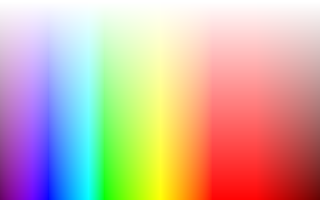 |
Note that we cleared the main buffer with the white color. Now change |
memset(buffer, 255, frame_width * frame_height * 3);
|
to |
memset(buffer, 0, frame_width * frame_height * 3);
|
The result: |
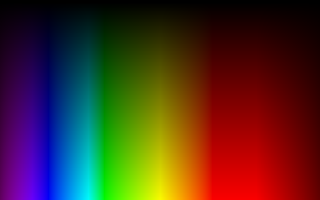 |
In other words, the alpha-mask works as a separete alpha-channel
mixed with rendered primitives.
The fact that it contains 8-bit values allows you to clip
all drawing to arbitrary shapes with perfect |
There are two basic renderers with almost the same functionality:
renderer_base and renderer_mclip. The first one is used most often
and it performs low level clipping. Clipping in general is a
complex task. In AGG there can be at least two levels of clipping,
the low (pixel) level, and the high (vectorial) level. These classes
perform the pixel level clipping to protect the buffer from
|
renderer_base and renderer_mclip are class templates parametrized with a pixel format renderer: |
template<class PixelFormat> class renderer_base { public: typedef PixelFormat pixfmt_type; typedef typename pixfmt_type::color_type color_type; . . . }; |
See sources renderer_base renderer_mclip |
renderer_base(pixfmt_type& ren); renderer_mclip(pixfmt_type& ren); |
Both classes accept a reference to the pixel format renderer.
renderer_mclip uses renderer_base<PixelFormat> inside itself to
perform implemented clipping to a single rectangle region.
Note that you can use pixfmt_amask_adaptor as |
The cost of creation is minimal, it's just initializing of the class member variables. But renderer_mclip allocates memory when you add new clipping rectangles and deallocates it when destroying. It uses the pod_deque class that allocates blocks of memory of equal size and never reallocates it. When you reset clipping, the memory is not deallocated, it's reused. The renderer_mclip deallocates memory only when destroying. This technique is widely used in AGG and prevents from deep memory fragmentation. |
const pixfmt_type& ren() const; pixfmt_type& ren(); |
Returns a reference to the pixel format renderer.
|
unsigned width() const; unsigned height() const; |
Returns width and height of the rendering buffer.
|
void reset_clipping(bool visibility); |
The function resets the clipping. If the |
| IMPORTANT! If you attach another memory buffer to the rendering_buffer, connected with this particular basic renderer, you must call reset_clipping, otherwise, the clipping box will be not valid.
It's because there's no any “feedback” from
the rendering buffer to the renderers, in other words, renderer_base
and renderer_mclip don't know anything if the rendering buffer is
changed. Having some mechanism of events or delegates would be
an overkill in this case. |
bool clip_box(int x1, int y1, int x2, int y2); |
Set new clipping box. Only renderer_base has this function.
The clipping box includes the boundaries, so that, the maximal
one is |
void add_clip_box(int x1, int y1, int x2, int y2); |
Add new clipping box. Only renderer_mclip has this function.
You can add any number of rectangular regions, but they must not
overlap. In case of overlapping areas, some elements can be drawn
twice or more. The clipping boxes are being clipped by the bounding
box |
void clip_box_naked(int x1, int y1, int x2, int y2); |
Only renderer_base has this function. Set new clipping box without
clipping to the rendering buffer size. This function is unsafe
and used in the renderer_mclip for fast switching between
partial regions when rendering. The purpose of this function
is just to avoid extra overhead.
|
bool inbox(int x, int y) const; |
Check if point |
void first_clip_box(); bool next_clip_box(); |
These two functions are used to enumerate all the clipping regions
of the renderer. In the renderer_base class they are empty,
|
const rect& clip_box() const; int xmin() const; int ymin() const; int xmax() const; int ymax() const; |
Returns the clipping box as a rectangle and as separate integer
values. In renderer_mclip the functions always return
|
const rect& bounding_clip_box() const; int bounding_xmin() const; int bounding_ymin() const; int bounding_xmax() const; int bounding_ymax() const; |
Returns the bounding clipping box as a rectangle and as separate
integer values. In renderer_base the functions always return
the same values as the respective ones from the previous group.
In renderer_mclip they return the bounding box calculated
on the basis of added regions.
|
void clear(const color_type& c); |
Clears the buffer with the given color without clipping.
|
void copy_pixel(int x, int y, const color_type& c); |
Set a pixel with clipping.
|
void blend_pixel(int x, int y, const color_type& c, cover_type cover); |
Blend a pixel with clipping. The behavior is the same as in the pixel
format renderers (pixfmt).
|
color_type pixel(int x, int y) const; |
Returns the value of the pixel with coordinates |
void copy_hline(int x1, int y, int x2, const color_type& c); void copy_vline(int x, int y1, int y2, const color_type& c); void blend_hline(int x1, int y, int x2, const color_type& c, cover_type cover); void blend_vline(int x, int y1, int y2, const color_type& c, cover_type cover); |
Draw (copy) or blend horizontal or vertical line of pixels.
The behaviour is the same as in pixel format renders
(pixfmt), but here you use coordinates of the begin and end
of the lines instead of |
void copy_bar(int x1, int y1, int x2, int y2, const color_type& c); void blend_bar(int x1, int y1, int x2, int y2, const color_type& c, cover_type cover); |
Draw (copy) or blend a solid bar (rectangle).
|
void blend_solid_hspan(int x, int y, int len, const color_type& c, const cover_type* covers); void blend_solid_vspan(int x, int y, int len, const color_type& c, const cover_type* covers); |
Blend a horizontal or a vertical solid-color span.
These functions are used when rendering solid Anti-Aliased polygons.
|
void blend_color_hspan(int x, int y, int len, const color_type* colors, const cover_type* covers); void blend_color_vspan(int x, int y, int len, const color_type* colors, const cover_type* covers); |
Blend a horizontal or a vertical color span. The functions are used with
different span generators, such as gradients, images, patterns,
Gouraud interpolation, etc. They accept an array of colors whose
type must be compatible with the used pixel format.
|
void blend_color_hspan_no_clip(int x, int y, int len, const color_type* colors, const cover_type* covers); void blend_color_vspan_no_clip(int x, int y, int len, const color_type* colors, const cover_type* covers); |
The same as above, but without clipping. These functions are
used in the scanline renderers. The reason to do so is the performance.
Tne scanline consists of a number of spans and it's a little bit
more efficient to perform clipping when we have information about
the whole scanline rather than to clip every span, especially in
renderer_mclip.
|
void copy_from(const rendering_buffer& from, const rect* rc=0, int x_to=0, int y_to=0); |
Copy a rectangular area of the buffer |
The code below is a very common example of declaring and using of the rendring buffer and low level renderers. |
// Typedefs of the low level renderers to simplify the declarations.
// Here you can use any other pixel format renderer and
// agg::renderer_mclip if necessary.
//--------------------------
typedef agg::pixfmt_rgb24 pixfmt_type;
typedef agg::renderer_base<agg::pixfmt_rgb24> renbase_type;
enum { bytes_per_pixel = 3 };
unsigned char* buffer = new unsigned char[frame_width *
frame_height *
bytes_per_pixel];
agg::rendering_buffer rbuf(buffer,
frame_width,
frame_height,
frame_width * bytes_per_pixel);
pixfmt_type pixf(rbuf);
renbase_type rbase(pixf);
rbase.clear(clear_color);
//. . .
|
At last we can clear the buffer with certain color instead of
“manual” calling of |
The primitives and marker renderers were added to AGG to provide you a mecahnism of fast drawing regular, aliased objects, such as lines, rectangles, and ellipses. The marker renderer can draw some shapes commonly used in different scatter plots. If you are not going to use it just skip this section. |
The header file: agg_renderer_primitives.h |
template<class BaseRenderer> class renderer_primitives { public: typedef BaseRenderer base_ren_type; typedef typename base_ren_type::color_type color_type; //. . . }; |
Here class RendererBase can be of type renderer_base or renderer_mclip. |
renderer_primitives(base_ren_type& ren) : m_ren(&ren), m_fill_color(), m_line_color(), m_curr_x(0), m_curr_y(0) {} |
The cost of creation is minimal, it's only initialization of the pointer
to the base renderer object, two colors and initial coordinates that are
used in |
static int coord(double c); |
Converts a coordinate of the |
void fill_color(const color_type& c); void line_color(const color_type& c); const color_type& fill_color() const; const color_type& line_color() const; |
Set and get the fill and line colors. The colors may have
the alpha value that will take effect, i.e., the primitives
will be alpha-blended.
|
void rectangle(int x1, int y1, int x2, int y2); |
Draw a rectangle without filling with the line color.
There are regular, pixel coordinates are used.
The width of the border is always 1 pixel and cannot
be changed.
|
void solid_rectangle(int x1, int y1, int x2, int y2); |
Draw a filled rectangle without border with the fill color.
The coordinates are in pixels.
|
void outlined_rectangle(int x1, int y1, int x2, int y2); |
Draw a filled rectangle with a border. There are both colors
line and fill are used.
|
void ellipse(int x, int y, int rx, int ry); void solid_ellipse(int x, int y, int rx, int ry); void outlined_ellipse(int x, int y, int rx, int ry); |
Draw ellipses, non-filled, filled and filled with a border.
The coordinates are integer, in pixels. |
void line(int x1, int y1, int x2, int y2, bool last=false); |
Draw a bresenham line with Subpixel Accuracy. The coordinates are in
integer format of 24.8, that is, in the 1/256 pixel units.
Flag |
void move_to(int x, int y); void line_to(int x, int y, bool last=false); |
The version of |
const base_ren_type& ren() const { return *m_ren; } base_ren_type& ren() { return *m_ren; } |
Returns a reference to the base renderer object.
|
const rendering_buffer& rbuf() const { return m_ren->rbuf(); } rendering_buffer& rbuf() { return m_ren->rbuf(); } |
Returns a reference to the rendering buffer attached to the base renderer. |
The header file: agg_renderer_markers.h |
The marker renderer can draw or alpha-blend the following simple shapes: |
enum marker_e { marker_square, marker_diamond, marker_circle, marker_crossed_circle, marker_semiellipse_left, marker_semiellipse_right, marker_semiellipse_up, marker_semiellipse_down, marker_triangle_left, marker_triangle_right, marker_triangle_up, marker_triangle_down, marker_four_rays, marker_cross, marker_x, marker_dash, marker_dot, marker_pixel }; |
|
template<class BaseRenderer> class renderer_markers : public renderer_primitives<BaseRenderer> { public: typedef renderer_primitives<BaseRenderer> base_type; typedef BaseRenderer base_ren_type; typedef typename base_ren_type::color_type color_type; // . . . }; |
|
renderer_markers(base_ren_type& rbuf) : base_type(rbuf) {} |
As you can see, the creation is as simple as the renderer_primitives one. |
All the marker functions accept |
void square(int x, int y, int r); void diamond(int x, int y, int r); void circle(int x, int y, int r); void crossed_circle(int x, int y, int r); void semiellipse_left(int x, int y, int r); void semiellipse_right(int x, int y, int r); void semiellipse_up(int x, int y, int r); void semiellipse_down(int x, int y, int r); void triangle_left(int x, int y, int r); void triangle_right(int x, int y, int r); void triangle_up(int x, int y, int r); void triangle_down(int x, int y, int r); void four_rays(int x, int y, int r); void cross(int x, int y, int r); void xing(int x, int y, int r); void dash(int x, int y, int r); void dot(int x, int y, int r); void pixel(int x, int y, int); |
Also, there are some functions for the convenience that basically just use
the |
void marker(int x, int y, int r, marker_e type); |
Draw a single marker of the given type.
|
template<class T> void markers(int n, const T* x, const T* y, T r, marker_e type); |
Draw a number of markers of the given type and radius and coordinates
stored in two arrays, |
template<class T> void markers(int n, const T* x, const T* y, const T* r, marker_e type); |
Draw a number of markers of the given type with coordinates and radii
stored in three arrays.
|
template<class T> void markers(int n, const T* x, const T* y, const T* r, const color_type* fill_colors, marker_e type); |
Draw a number of markers of the given type with coordinates and radii
stored in three arrays and of different fill colors.
|
template<class T> void markers(int n, const T* x, const T* y, const T* r, const color_type* fc, const color_type* lc, marker_e type); |
Draw a number of markers of the given type with coordinates and radii
stored in three arrays and of different fill and line colors.
|